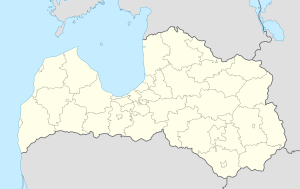Baloži facts for kids
Quick facts for kids
Baloži
|
|||
|---|---|---|---|
|
Town
|
|||

Riga street in Baloži
|
|||
|
|||
| Country | |||
| Municipality | Ķekava Municipality | ||
| Town rights | 1991 | ||
| Area | |||
| • Total | Lua error in Module:Wd at line 1,575: attempt to index field 'wikibase' (a nil value). km2 (Formatting error: invalid input when rounding sq mi) | ||
| • Land | Lua error in Module:Wd at line 1,575: attempt to index field 'wikibase' (a nil value). km2 (Formatting error: invalid input when rounding sq mi) | ||
| • Water | Expression error: Unexpected < operator. km2 (Formatting error: invalid input when rounding sq mi) | ||
| Elevation | 18 m (59 ft) | ||
| Population | |||
| • Total | Lua error in Module:Wd at line 1,575: attempt to index field 'wikibase' (a nil value). | ||
| Time zone | UTC+2 (EET) | ||
| • Summer (DST) | UTC+3 (EEST) | ||
| Postal code |
LV-2128; LV-2112
|
||
| Calling code | +371 67 | ||
Baloži is a small town in Latvia. It is located in the Ķekava Municipality, only 12 kilometers away from the center of Riga. In 2021, about 6,746 people lived there.
Baloži started as a village shortly after Second World War. It was built for people who worked at a nearby peat factory. Peat is a type of soil made from decayed plants, often used as fuel. The oldest part of Baloži has buildings in a special style called Stalinist architecture.
During the 1970s, the village grew bigger. It expanded towards the A7 highway. In the 1980s, this new area became a modern neighborhood called Titurga. Baloži officially became a town in 1991. After some changes in Latvia in 2009, Baloži became part of the Ķekava Municipality. This means it is one of the few towns in Latvia that is not the main center of its municipality. Baloži is part of the Vidzeme region in Latvia.
Rail Network
Baloži once had its own small train system. This network was about 28 kilometers long. It was built to help transport peat from the local factory.
See also
 In Spanish: Baloži para niños
In Spanish: Baloži para niños




